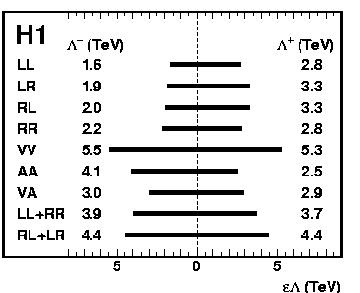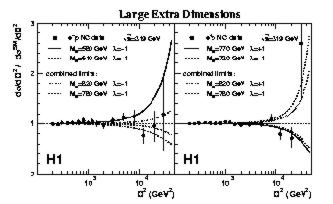Search for New Physics in e+/-q Contact Interactions at HERA
|
Using the full data samples available from the first phase of HERA running,
the H1 collaboration has measured the cross sections for the inclusive
cross sections
e+p-->e+X and
e-p-->e-X over a huge range in squared
four-momentum transfer Q2 up to
Q2 = 30000 GeV2. In this paper, the compatibility of
the data with the expectations of the Standard Model
of strong and electroweak interactions is tested. At the highest Q2,
where distance scales down to 1/1000 of the proton radius are probed,
deviations of the data from the standard model could indicate the presence
of quark substructure or new particles.
 The data show no significant deviation from the expectation
of the Standard Model and are hence used to place exclusion limits. The
analysis can be conveniently expressed in the framework of so called
`contact interactions', where any deviation due to a new particle would
correspond to a heavy mass scale. The sensitivity depends on the chiral
structure, i.e. the handedness of the eq-interaction. H1 was thus able
to establish stringent lower limits on the mass scale in the range between
1.6 and 5.5 TeV for various chiral combinations. These limits are illustrated
in the first figure for the various different scenarios and for positive and
negative interference of the new physics channel with Standard Model
processes.
The data show no significant deviation from the expectation
of the Standard Model and are hence used to place exclusion limits. The
analysis can be conveniently expressed in the framework of so called
`contact interactions', where any deviation due to a new particle would
correspond to a heavy mass scale. The sensitivity depends on the chiral
structure, i.e. the handedness of the eq-interaction. H1 was thus able
to establish stringent lower limits on the mass scale in the range between
1.6 and 5.5 TeV for various chiral combinations. These limits are illustrated
in the first figure for the various different scenarios and for positive and
negative interference of the new physics channel with Standard Model
processes.
The contact interaction framework is also used to set limits on various
other extensions to the standard model. Couplings (lambda) and masses (M)
of leptoquarks or R-parity violating squarks (particles which can couple
to a quark and a lepton) are constrained to M / lambda > 0.3 - 1.4 TeV
depending on the details of the model.
There has been much recent speculation on the possibility of
deviations from Newton's gravitational law in the sub-millimeter
range in models with large extra dimensions beyond the standard 3+1
dimensions of space and time. This could show up in the
H1 data through the exchange of virtual gravitons coupling to quarks and
gluons. A lower limit of 0.8 TeV is set on the resulting effective Planck
scale. The second figure illustrates how large extra dimensions with this
characteristic scale would alter the ratio of the measured cross section
d sigma / d Q2 to the Standard Model prediction.

Finally, a `form factor' analysis is performed to search for quark or
electron substructure. The light quarks are
shown to have a spatial size (if any) smaller than 10-18 m.
So as yet, there is no indication in the H1 data for deviations from the
standard model at the highest Q2 values studied. However, there
is still scope for more sensitive tests in the future with the large increase
in luminosity and polarisation of the lepton beams expected in the next few
years.
Last Update May 9, 2003
 The data show no significant deviation from the expectation
of the Standard Model and are hence used to place exclusion limits. The
analysis can be conveniently expressed in the framework of so called
`contact interactions', where any deviation due to a new particle would
correspond to a heavy mass scale. The sensitivity depends on the chiral
structure, i.e. the handedness of the eq-interaction. H1 was thus able
to establish stringent lower limits on the mass scale in the range between
1.6 and 5.5 TeV for various chiral combinations. These limits are illustrated
in the first figure for the various different scenarios and for positive and
negative interference of the new physics channel with Standard Model
processes.
The data show no significant deviation from the expectation
of the Standard Model and are hence used to place exclusion limits. The
analysis can be conveniently expressed in the framework of so called
`contact interactions', where any deviation due to a new particle would
correspond to a heavy mass scale. The sensitivity depends on the chiral
structure, i.e. the handedness of the eq-interaction. H1 was thus able
to establish stringent lower limits on the mass scale in the range between
1.6 and 5.5 TeV for various chiral combinations. These limits are illustrated
in the first figure for the various different scenarios and for positive and
negative interference of the new physics channel with Standard Model
processes.
